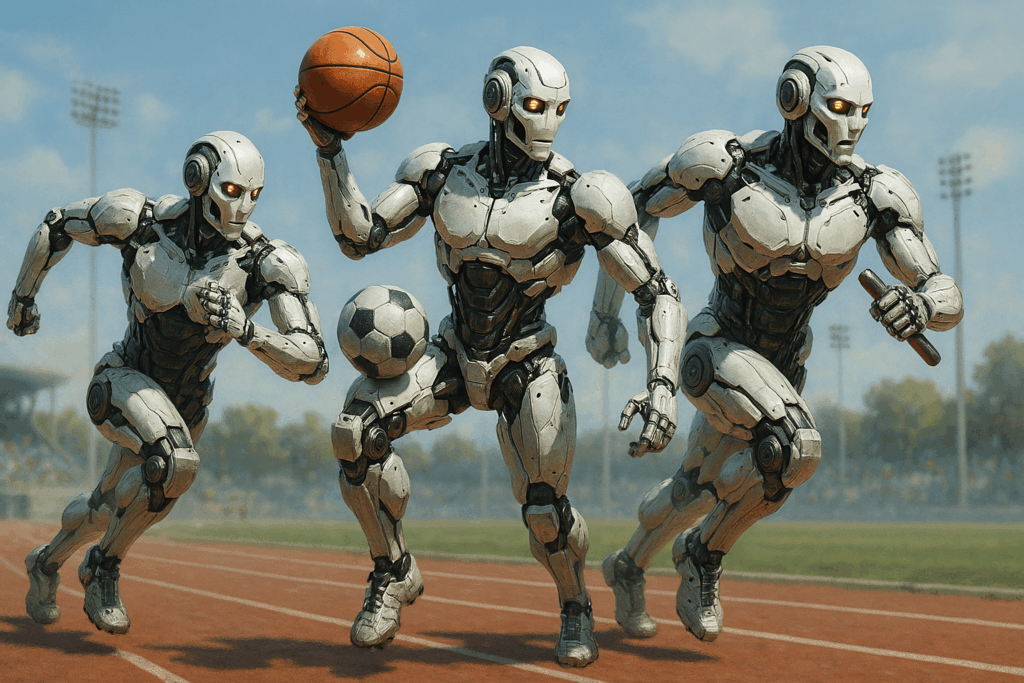
The whirring of servos, the click of articulated joints, and the silent precision of movement – these are the sounds of the future of sports. No longer confined to the realm of science fiction, robotic athletes are now competing in simulated games, sparking a fierce debate about the very nature of skill, athleticism, and the definition of “human” achievement. These competitions, while currently confined to virtual environments, represent a significant step towards a future where artificial intelligence (AI) and robotics may redefine our understanding of athletic prowess.
The current iterations of robotic athletes are far from humanoid in appearance. Many resemble specialized machines, optimized for specific tasks within the simulated games. For instance, in a simulated running race, a robotic competitor might be a highly streamlined chassis with advanced leg mechanisms designed for speed and efficiency, eschewing the complexities of a humanoid form. Similarly, a robotic gymnast in a virtual competition might consist of a series of articulated limbs perfectly calibrated for rotations and complex maneuvers, ignoring the human limitations of balance and flexibility.
This specialization highlights a key aspect of the debate: is the skill demonstrated by these robotic athletes truly comparable to human skill? Proponents of robotic athleticism argue that these machines display a level of precision and speed far exceeding human capabilities. Their algorithms, trained on vast datasets of human performance and optimized through machine learning, can execute movements with an accuracy and consistency impossible for a human athlete, even at the peak of their performance. They point to the ability of robots to achieve superhuman feats, like performing a perfect triple backflip with unwavering consistency, as evidence of their superior “athleticism.”
Conversely, critics argue that robotic skill lacks the intrinsic qualities that define human athleticism. They contend that the essence of human athletic performance lies not just in physical capability, but also in the elements of strategy, adaptability, and emotional resilience. A human athlete faces unpredictable variables during a competition – fatigue, injury, opponent tactics, crowd pressure – that necessitate rapid decision-making and mental fortitude. A robot, by contrast, operates within a predetermined framework, reacting to pre-programmed scenarios. While it might excel within those parameters, it lacks the creative improvisation and instinctive reactions that characterize human performance.
Furthermore, the debate extends beyond the purely athletic. The development of robotic athletes involves substantial human ingenuity, raising questions about the attribution of achievement. The design, programming, and training of these robots are complex processes demanding years of work by engineers, programmers, and AI specialists. Therefore, is the “athletic” achievement of the robot truly its own, or is it a reflection of the collective human effort behind it? This mirrors discussions around AI-generated art and music, questioning the role of the human creator in the final product.
The competitive landscape itself is also evolving. Early robotic competitions often focused on specific tasks, allowing for a straightforward comparison between robot and human performance. However, more recent competitions are incorporating elements of strategy and unpredictability, challenging robots to adapt to dynamic environments and unexpected situations. This pushes the boundaries of AI development and forces a reconsideration of what constitutes “skill” in this context. The creation of more sophisticated AI algorithms, capable of real-time learning and adaptation, could potentially bridge the gap between robotic and human athletic performance.
The development of robotic athletes has ethical implications as well. As robotic performance improves, concerns arise about the potential displacement of human athletes and the impact on the sporting industry. The allure of superhuman performance might lead to a shift in audience preference, potentially diminishing the value of human competition. This raises questions about the future of sports and the role of human participation in a world increasingly dominated by technological advancements.
In conclusion, the rise of robotic athletes competing in simulated games presents a complex and multifaceted debate. While robots may surpass humans in terms of precision and speed within specific parameters, the question of whether their achievements truly equate to human athletic skill remains a subject of ongoing discussion. The debate compels us to re-examine our understanding of athleticism, achievement, and the very definition of human potential in a world rapidly evolving with the advancements of AI and robotics. The future of sports, and indeed our relationship with technology, hangs in the balance as these robotic competitors continue to push the boundaries of what is possible. The competition is not simply between robot and human, but between different conceptions of skill, intelligence, and the very essence of athletic achievement.